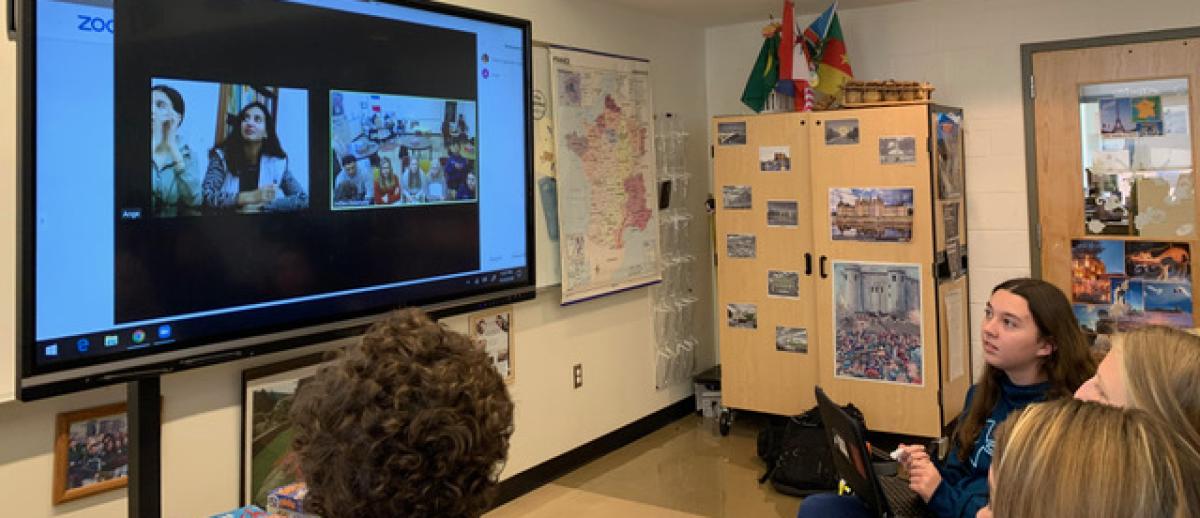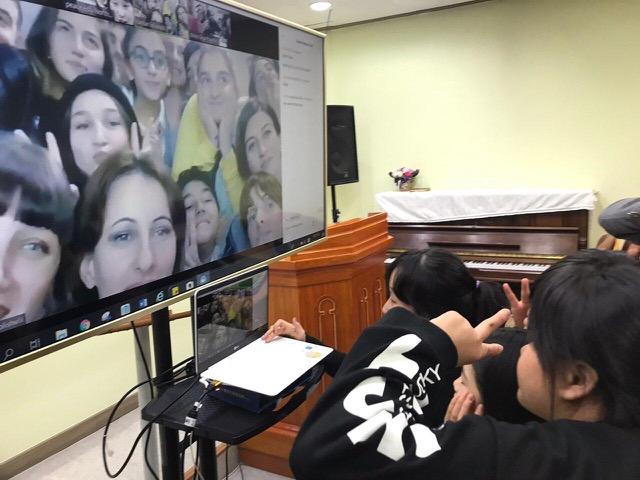Fostering Global Competency in Secondary Education
archive


Students in Virginia, U.S. connect in French with their peers in El Jadida, Morocco via a video conference. (Photo Credit: JoEllen Delamatta)
Fostering Global Competency in Secondary Education
Learning through interacting and with the world are key to gaining global understanding. I have witnessed this first-hand over many years of personal experience and professional work in global education, where stepping into the shoes of the other, experiencing different lifestyles and listening to new and diverse perspectives, all lead to a path toward global understanding.
My first extensive experience of another culture was as a high school gap year exchangee in Seoul, South Korea, where I found myself immersed in Korean language, culture, school, and family life. I returned to the US and university with language skills, cross-cultural awareness, and altered career directions that have remained with me over many decades. Following a BA in Japanese political science, I later received a Masters in Korean History and a PhD in Japanese history. These made possible a varied career that included university teaching, work at the US House of Representatives’ International Relations Committee, and numerous translation and interpreting opportunities.
I am one of a fortunate few who have had such an international experience and was very excited when, in 1979, I was tapped to become the Executive Director of the organization that had sent me to Korea, the International Cultural Youth Exchange. ICYE had been sending youth internationally since 1949 and I now had the opportunity to enable hundreds of young people to experience another country, language and culture first-hand—as I had done and from which I had so greatly benefitted. ICYE was not a typical high school study abroad program. A key principle of ICYE is that exchangees have to identify, delve into, and address a socio-economic issue in their host country as part of the exchange experience. In short, we were expected to step into the shoes of our cultural peers as participants, not simply as observers.
During my term at the organization, I helped launch the Council on Standards for international Educational Travel (CSIET) in the mid-1980s to establish measurable standards for high school exchange programs and measurable data on the number of young people engaged in International exchanges. These data were valuable for ascertaining the ages, gender, countries of origin and hosting, and other characteristics of high school exchangees. They also revealed the infinitesimally small percentage of US students who participate in these international exchange experiences. For example, in the 2018-1019 academic year, a total of 1,883 US high school students went abroad for a semester or a year. This compares to a total of over 15 million high school students in the US according to the National Center for Education Statistics, meaning that about .0012% of US high school students went abroad for a semester or year. According to NAFSA, a slightly higher percentage (1.7%) of enrolled university students studied abroad in 2017-2018.
Thus we in the exchange field were enabling youth to have transformational experiences personally, but still we were not impacting very many students in the high school and university age groups. In the late 1980s I came to realize the value of connective technologies to facilitate interaction more effectively among member countries within a global organization. When online platforms were being pioneered for students to connect and interact globally, I immediately recognized that now an entire class or even school could have an interactive, cross-cultural experience internationally, without having to travel. So I jumped to a start-up NGO called International Education and Resource Network (iEARN), which had piloted a project linking twelve schools in Moscow (in the USSR) and twelve in New York State for online, collaborative, project-based learning. Over the next two decades, I was able to help expand the iEARN network to encompass organizations in 130+ countries, daily engaging 30,000 teachers and over a million students in online interactive collaboration. Over the past 30+ years, approximately 25 million young people have been involved.
Global Competency
Most importantly, these young people were able to have a transformational experience through their direct interaction with peers globally, without the expense of travel. Further, these collaborative projects, all designed and implemented by the network’s teachers, stress mutual empathy and caring. In a 2018 survey, over 90% of the participating teachers responded that their students engaged more deeply in the academic parts of the online project work when students established caring and empathetic relationships with their partners worldwide. iEARN educators, like others in the physical and virtual exchange communities, have documented the importance of peer-to-peer interaction in developing global competency. But in addition, iEARN educators have found that academic success is heightened in a caring interactive environment.1
...these young people were able to have a transformational experience through their direct interaction with peers globally, without the expense of travel. Further, these collaborative projects, all designed and implemented by the network’s teachers, stress mutual empathy and caring.
Two of the four pillars of the global competence matrix developed by The Council of Chief State School Officers (CCSSO) and Asia Society (Mansilla and Jackson 2011) involve interaction with peers in other countries. Through this interaction, students both listen to others’ perspectives and express their own opinions and information. That interaction (together with earlier general global awareness) then leads to student action and global competence. However, does the nature and content of the interaction impact students’ (and teachers’) journeys toward global competence?
Our research2 indicates, first, that students are more motivated to learn when engaged collaboratively in project-based learning, working together toward a common goal on projects and issues that they care about; secondly, that students need processes through which they can create bonds of friendship, caring, and empathy, as well as engaging in academic work; and finally, that in developing student global competence, success is based on how students know others in other cultures as much as it is what they know about the project on which they are working.

Students in South Korea and the Republic of Georgia discuss and practice such skills as empathy, critical thinking, communication and understanding during a video conference for the iEARN project, Virtual Peace Education Camp.
In January 2020, the World Economic Forum (WEF) identified iEARN as one of 16 models for the future of education for the 4th Industrial Revolution because it enhances interpersonal skills through online collaboration and interaction.3 The WEF concluded that in education for the “4th Industrial Revolution” students must develop the following:
1. Global citizenship skills: Include content that focuses on building awareness about the wider world, sustainability, and playing an active role in the global community.
2. Innovation and creativity skills: Include content that fosters skills required for innovation, including complex problem-solving, analytical thinking, creativity, and systems analysis.
3. Technology skills: Include content that is based on developing digital skills, including programming, digital responsibility, and the use of technology.
4. Interpersonal skills: Include content that focuses on interpersonal emotional intelligence, including empathy, cooperation, negotiation, leadership, and social awareness.
5. Personalized and self-paced learning: Move from a system where learning is standardized to one based on the diverse individual needs of each learner, and flexible enough to enable each learner to progress at their own pace.
6. Accessible and inclusive learning: Move from a system where learning is confined to those with access to school buildings to one in which everyone has access to learning.
7. Problem-based and collaborative learning: Move from process-based to project- and problem-based content delivery, requiring peer collaboration and more closely mirroring the future of work.
8. Lifelong and student-driven learning: Move from a system where learning and skilling decrease over one’s lifespan to one where everyone continuously improves on existing skills and acquires new ones based on their individual needs.
...in developing student global competence, success is based on how students know others in other cultures as much as it is what they know about the project on which they are working.
Conclusion
iEARN was clearly designed to address all these skills, but the WEF focused on skill #4, Interpersonal Skills, as a defining aspect of iEARN, recognizing that global interaction without empathy and cooperation is not sufficient. Indeed, this principle is built into the constitution and content of every project undertaken by teachers and students. The preamble of the constitution states: “The vision and purpose of iEARN is to enable young people to undertake projects designed to make a meaningful contribution to the health and welfare of the planet and its people.” In designing new projects, educators need to answer a number of questions (student ages, languages, curriculum application, etc.). One of those questions asks teachers to identify how the project, whether in the arts, sciences, social studies, etc., will address the vision statement and improve the quality of the planet and its people. Therefore, this expectation is built into project work from the very beginning and is a glue that holds the network together.
Over these many years, I have come to appreciate how both physical and virtual exchanges can contribute significantly toward global competency. And it is clear from research and experience that both of these exchange types will do better at achieving it if they have empathetic and caring interaction built into their programming.
1. Wiske, Martha Stone; Rennebohm Franz, Kristi; Breit, Lisa (2005), Teaching for Understanding with Technology, San Francisco, Jossey-Bass.
2. Research is based on a survey and interviews with iEARN teachers in 18 countries in 2016 conducted by Lisa Jobson and the author. Contact the author for a copy of the research paper and its conclusions.
3. World Economic Forum (2019), Schools of the Future Report, January 2020. See http://www3.weforum.org/docs/WEF_Schools_of_the_Future_Report_2019.pdf



